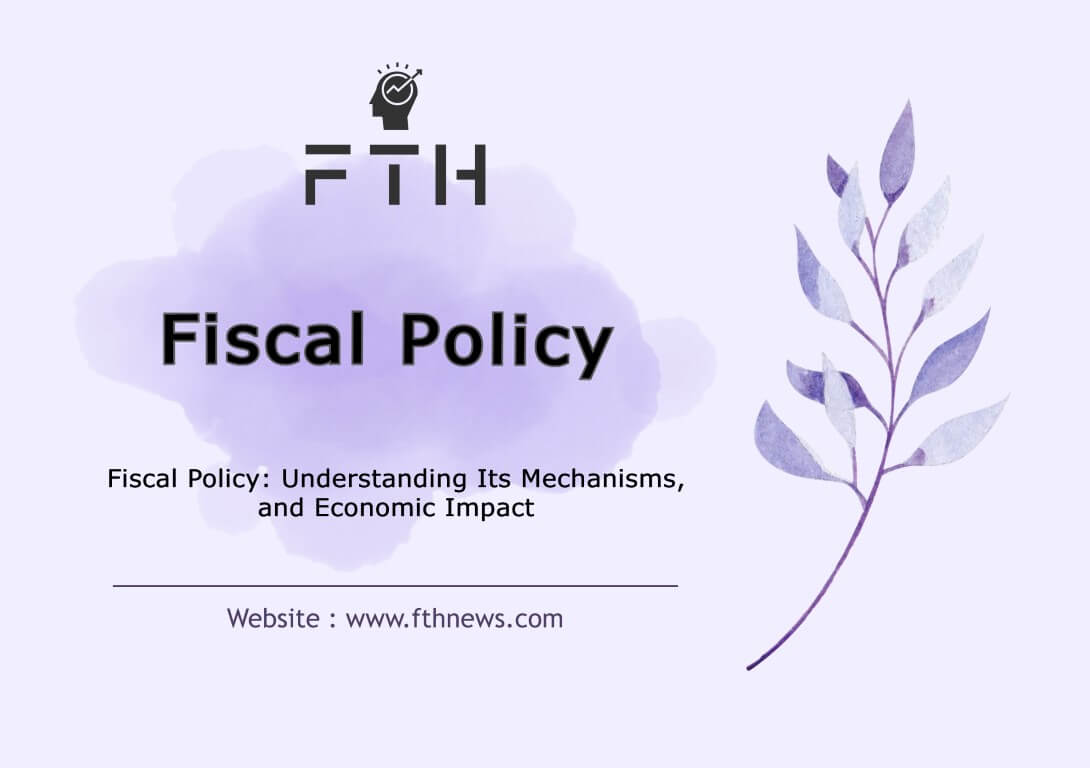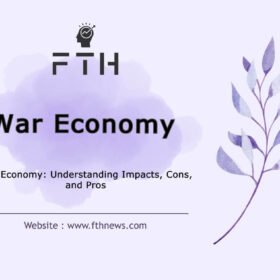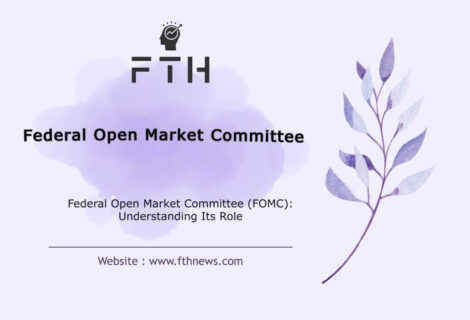
Fiscal Policy: Understanding Its Mechanisms, and Economic Impact
Fiscal policy, shaped by John Maynard Keynes’s theories, involves government’s use of spending and taxes to regulate economic conditions.
It aims to stabilize the economy by adjusting spending and tax policies in response to private sector fluctuations. During a slump, the government increases spending or cuts taxes to boost demand; during periods of excessive private spending, it decreases spending or raises taxes to manage demand.
This cycle of expansionary and contractionary fiscal policies helps stabilize the economy, fostering growth and preventing crises.
What is Fiscal Policy?
Fiscal policy involves government strategies in managing the economy through the manipulation of spending and tax policies. These decisions aim to influence economic stability and achieve specific goals like reducing unemployment, fostering economic growth, and controlling inflation.
Working hand-in-hand with monetary policy, fiscal policy serves as a critical tool in governmental economic management.
Historical Evolution of Fiscal Policy
The roots of fiscal policy trace back to ancient times. In ancient Rome, governing bodies utilized fiscal policy by adjusting tax rates and public spending to manage their economy. However, the modern concept took shape in the 20th century, particularly during the Great Depression.
Amid the severe economic downturn of the 1930s, governments globally adopted fiscal policies to stimulate economic activity. President Franklin D. Roosevelt’s New Deal in the United States stands as a prominent example, marked by substantial public spending on infrastructure and social programs.
Post-World War II, fiscal policies remained pivotal in managing economies, with a focus on fostering economic growth and reducing unemployment. This period witnessed the adoption of Keynesian policies, emphasizing government spending to bolster economic demand, named after economist John Maynard Keynes.
The subsequent decades, notably the 1970s and 1980s, posed new challenges for fiscal policies, including escalating inflation and mounting public debt. In response, many governments pivoted to conservative fiscal strategies, encompassing reduced government spending and tax cuts to counter inflation and balance budgets.
In recent years, fiscal policies have continued to adapt to new economic challenges and changing global conditions. Notably, during the global financial crisis of 2008-2009, governments worldwide leveraged fiscal policies to stimulate economic activity and prevent prolonged recession.
The Impact of Fiscal Policy on the Economy
fiscal policies wield a significant influence on the economy, facilitating specific economic goals such as stimulating growth, curbing inflation, and increasing employment. However, their effectiveness relies on various factors, including the existing economic conditions, policy types implemented, and policymakers’ ability to balance short-term and long-term objectives.
Economic Growth:
Fiscal policy, determined by government spending and taxes, significantly influences economic growth. Expansionary fiscal policy, through increased spending or reduced taxes, fosters economic activity and higher GDP growth. Conversely, contractionary fiscal policy, with reduced spending or increased taxes, can lead to decreased economic activity and lower GDP growth.
Inflation:
Fiscal policy also shapes inflation by manipulating the money flow in the economy. Expansionary policies can spike demand for goods and services, potentially causing price hikes and inflation. Contrarily, contractionary policies can counter inflation by moderating demand and curbing price increases.
Employment:
Fiscal policy affects employment levels by impacting economic growth and labor demand. Expansionary fiscal policies can bolster employment due to increased government spending and demand, creating job opportunities. Conversely, contractionary fiscal policies can result in reduced employment as decreased government spending diminishes job prospects.
Income Distribution:
Tax rates and government spending on social programs under fiscal policy play a role in income distribution. Higher taxes on the affluent and increased spending on social programs can promote a more equitable income distribution, while reduced taxes on the wealthy and decreased social spending can foster income inequality.
Expansionary Policies
Fiscal policy can be a powerful tool to stimulate economic growth, especially during a recession. When an economy is struggling, the government can employ expansionary fiscal policies to reignite demand and encourage growth.
Tax Rebates:
One approach is to issue stimulus tax rebates, allowing people to retain more of their income. This extra money in people’s pockets leads to increased spending and investment, ultimately boosting aggregate demand. As demand rises, businesses expand, unemployment decreases, and competition for labor increases, which, in turn, drives up wages and gives consumers more income to spend and invest.
Government Spending:
Alternatively, the government can stimulate economic development by increasing its spending without corresponding tax increases. For example, investing in infrastructure projects like building highways creates employment, generates demand, and fuels growth.
Expansionary fiscal policies typically involve “deficit spending,” where government expenditures exceed revenue from taxes and other sources. This approach aligns with the theories of fiscal policy pioneer John Maynard Keynes, who believed that countries could use spending and tax policies to stabilize the business cycle and regulate economic output.
Disadvantages of Expansionary Policy
Critics often debate the effectiveness of expansionary fiscal policies. Some economists argue that excessive government spending can crowd out private sector investments. Additionally, implementing expansionary policies can be politically challenging, as voters generally prefer lower taxes and public spending.
However, unchecked expansion can lead to inflation and the formation of asset bubbles, posing risks to the economy. High inflation and the potential for widespread defaults when bubbles burst can necessitate a shift toward contractionary policies, in which the government or central banks aim to cool down an overheated economy.
Advantages of Expansionary Policy
1. Economic Stimulus: Expansionary fiscal policies act as a vital catalyst during economic downturns. By increasing government spending or reducing taxes, these policies inject much-needed demand into the economy, reviving growth and employment.
2. Countering Recessions: During recessions, such policies offer a lifeline. They help mitigate the adverse effects of economic slumps by boosting consumer and business spending, thus aiding in job creation and preventing prolonged periods of unemployment.
3. Infrastructure and Development: Increased government spending, particularly in infrastructure projects, not only generates immediate employment opportunities but also lays the groundwork for long-term economic development and improved public services.
4. Balancing Business Cycles: Expansionary policies work to stabilize the economy by countering the natural fluctuations in the business cycle. This proactive approach seeks to manage fluctuations, maintaining a more consistent and predictable economic environment.
5. Addressing Income Disparities: By bolstering demand and job creation, expansionary policies can potentially address income disparities, as increased employment often leads to higher wages and improved living standards for many.
Contractionary Policies
Addressing Inflation and Overheating: When an economy experiences rising inflation and signs of overheating, a government may deploy contractionary fiscal policies. These measures aim to rebalance the business cycle, even if it means inducing a short-term recession. The government implements this by increasing taxes, reducing public spending, and potentially lowering wages for government jobs.
Budget Surplus and Unpopularity: Unlike the deficit spending seen in expansionary policies, contractionary fiscal policy involves achieving a budget surplus. However, it’s infrequently employed due to its unpopularity among the public. Policymakers often face a dilemma in opting for contractionary fiscal policies due to their lack of popularity.
Monetary Policy as an Alternative: To manage unsustainable growth, governments more commonly resort to contractionary monetary policy. This approach involves actions like raising interest rates and constraining the supply of money and credit to counteract inflation.
Advantages of Contractionary Policies
Inflation Control: These policies are effective in controlling rising inflation by curbing excessive demand, thereby maintaining price stability within the economy.
Long-Term Stability: By preventing overheating and subsequent economic bubbles, contractionary policies contribute to the long-term stability of the economy, preventing severe economic crises.
Disadvantages of Contractionary Policies
Potential Recession: The application of these policies, especially in an economy with high inflation, could lead to a short-term recession or economic slowdown.
Unpopularity and Political Challenges: Governments often face resistance in implementing contractionary measures due to their unpopularity among the public. Austerity measures, such as cuts in public spending and potential job wage reductions, are generally met with opposition.
Economic Schools and Fiscal Policies
Keynesians believe that implementing fiscal policies profoundly impacts three critical facets within a country:
1. Allocation: Through government’s judicious political-economic decisions, optimal resource allocation across various sectors can yield remarkable societal outcomes. Thus, it’s imperative for government fiscal policies to ensure the most efficient allocation of resources.
2. Distribution: Government fiscal policies wield direct control over income distribution within a country. The government determines sectoral subsidies and tax collection, thereby becoming the key influencer in income distribution. This emphasizes the need to propose the most effective method for fair income distribution.
3. Stabilization: Fiscal policies emerge as the ideal tool for stabilizing aggregate demand in society, as per Keynesians. Conversely, classical economists and monetarists refute the notion of fiscal policies as a means to stabilize aggregate demand in society.
Comparative Perspectives:
Classical Economists and Monetarists: Their skepticism towards fiscal policies as a tool for stabilizing aggregate demand stems from the belief in self-correcting markets. They often advocate for limited government intervention, emphasizing free-market mechanisms to regulate economic cycles.
Keynesian Framework: Keynesians argue that during economic downturns, market corrections might be insufficient. They advocate for government intervention through increased spending to stimulate demand and bolster employment, thus supporting economic recovery.
Fiscal Policy Impact:
Resource Allocation: Effective allocation ensures efficient utilization of resources across sectors, optimizing economic growth and societal well-being. Governments strive to allocate resources strategically for long-term prosperity.
Income Distribution: The government’s role in income distribution impacts social equity. Varying tax structures and subsidy allocations influence the wealth distribution among different socio-economic classes.
Aggregate Demand Stabilization: Controlling demand fluctuations is critical for economic stability. Fiscal policies influence consumer spending and investment, affecting the overall demand within the economy.
Contemporary Challenges:
Global Dynamics: In today’s interconnected world, domestic fiscal policies can have international repercussions. Governments must consider global impacts when crafting fiscal strategies.
Technological Transformations: The digital age and technological advancements continually reshape economic landscapes, posing new challenges for fiscal policies in adapting to changing market dynamics.
Conclusion
Fiscal policy stands as a potent instrument wielded by governments to steer the economy through adjustments in government spending and tax policies. Its primary aims encompass promoting economic growth, controlling inflation, and fostering an equitable income distribution. The impacts of fiscal policy ripple through the economy, influencing economic growth, inflation rates, employment levels, and income distribution. By prudently implementing fiscal policies, governments can attain specific economic objectives and foster enduring economic stability.
It’s crucial to recognize that fiscal policy operates in tandem with other economic strategies, including monetary and trade policies, to achieve macroeconomic stability. Policymakers must embrace a comprehensive approach to economic management, considering a multitude of factors that impact the economy. Balancing these factors is key to achieving economic objectives.
In essence, fiscal policy stands as an indispensable tool for governments in advancing economic growth, curbing inflation, and nurturing a more just society. Leveraging the potential of fiscal policy, governments can chart a path towards a more prosperous future for their citizens, ensuring sustainable and enduring economic stability.
FAQ
Fiscal policy refers to the government’s use of spending and taxation to manage the economy, aiming to influence economic activity, employment, and inflation.
Fiscal policy can potentially reduce inflation by adjusting government spending and taxation to manage demand in the economy. Cutting government spending or increasing taxes can help curb excessive demand, which may mitigate inflationary pressures.
Fiscal policy involves government decisions on spending and taxation, impacting the economy directly. Monetary policy is managed by the central bank, influencing the money supply and interest rates, indirectly affecting the economy.
Fiscal policy is crafted and enacted by a country’s government, typically through legislative bodies and executive branches responsible for budgeting, spending, and taxation decisions.
The three main fiscal policies are:
Expansionary Fiscal Policy: Aimed at boosting economic growth by increasing government spending or reducing taxes.
Contractionary Fiscal Policy: Designed to slow down economic growth by cutting government spending or raising taxes.
Neutral Fiscal Policy: Maintaining current government spending and taxation levels, neither boosting nor restricting economic growth.














